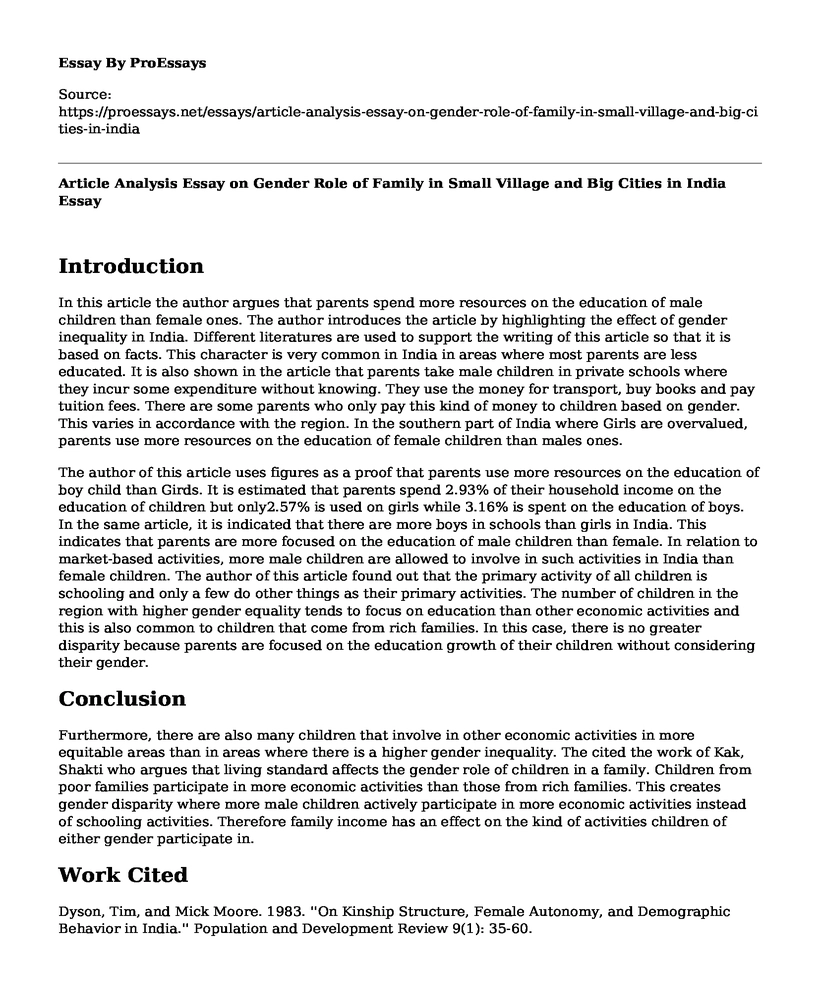Introduction
In this article the author argues that parents spend more resources on the education of male children than female ones. The author introduces the article by highlighting the effect of gender inequality in India. Different literatures are used to support the writing of this article so that it is based on facts. This character is very common in India in areas where most parents are less educated. It is also shown in the article that parents take male children in private schools where they incur some expenditure without knowing. They use the money for transport, buy books and pay tuition fees. There are some parents who only pay this kind of money to children based on gender. This varies in accordance with the region. In the southern part of India where Girls are overvalued, parents use more resources on the education of female children than males ones.
The author of this article uses figures as a proof that parents use more resources on the education of boy child than Girds. It is estimated that parents spend 2.93% of their household income on the education of children but only2.57% is used on girls while 3.16% is spent on the education of boys. In the same article, it is indicated that there are more boys in schools than girls in India. This indicates that parents are more focused on the education of male children than female. In relation to market-based activities, more male children are allowed to involve in such activities in India than female children. The author of this article found out that the primary activity of all children is schooling and only a few do other things as their primary activities. The number of children in the region with higher gender equality tends to focus on education than other economic activities and this is also common to children that come from rich families. In this case, there is no greater disparity because parents are focused on the education growth of their children without considering their gender.
Conclusion
Furthermore, there are also many children that involve in other economic activities in more equitable areas than in areas where there is a higher gender inequality. The cited the work of Kak, Shakti who argues that living standard affects the gender role of children in a family. Children from poor families participate in more economic activities than those from rich families. This creates gender disparity where more male children actively participate in more economic activities instead of schooling activities. Therefore family income has an effect on the kind of activities children of either gender participate in.
Work Cited
Dyson, Tim, and Mick Moore. 1983. ''On Kinship Structure, Female Autonomy, and Demographic Behavior in India.'' Population and Development Review 9(1): 35-60.
Miller, Barbara D. 1981. The Endangered Sex: Neglect of Female Children in Rural India. Ithaca: Cornell University Press.
Afridi, Farzana. 2006. ''Female Empowerment and the Gender Gap in Schooling in India.'' Working paper, Syracuse University, New York
Kak, Shakti. 2004. ''Magnitude and Profile of Child Labour in the 1999s: Evidence from the NSS Data.'' Social Scientist 32(1-2): 45-73.
Cite this page
Article Analysis Essay on Gender Role of Family in Small Village and Big Cities in India. (2022, May 05). Retrieved from https://proessays.net/essays/article-analysis-essay-on-gender-role-of-family-in-small-village-and-big-cities-in-india
If you are the original author of this essay and no longer wish to have it published on the ProEssays website, please click below to request its removal:
- Essay Sample on Christmas Cards
- Critical Analysis of a Concert of Houston Choral Society Essay
- Betel Quid Chewing in South-East Asia Paper Example
- World Music Concert Report: Mister Africa Concert
- Exploring Art Through Visitation of Perez Art Museum Miami - Essay Sample
- Essay Example on Ancient Bronze 'Sleeping Eros' - Unique Exhibit at NYC Met Art Museum
- Culture: Embracing Unique Identities for Social Bonding - Research Paper Sample







